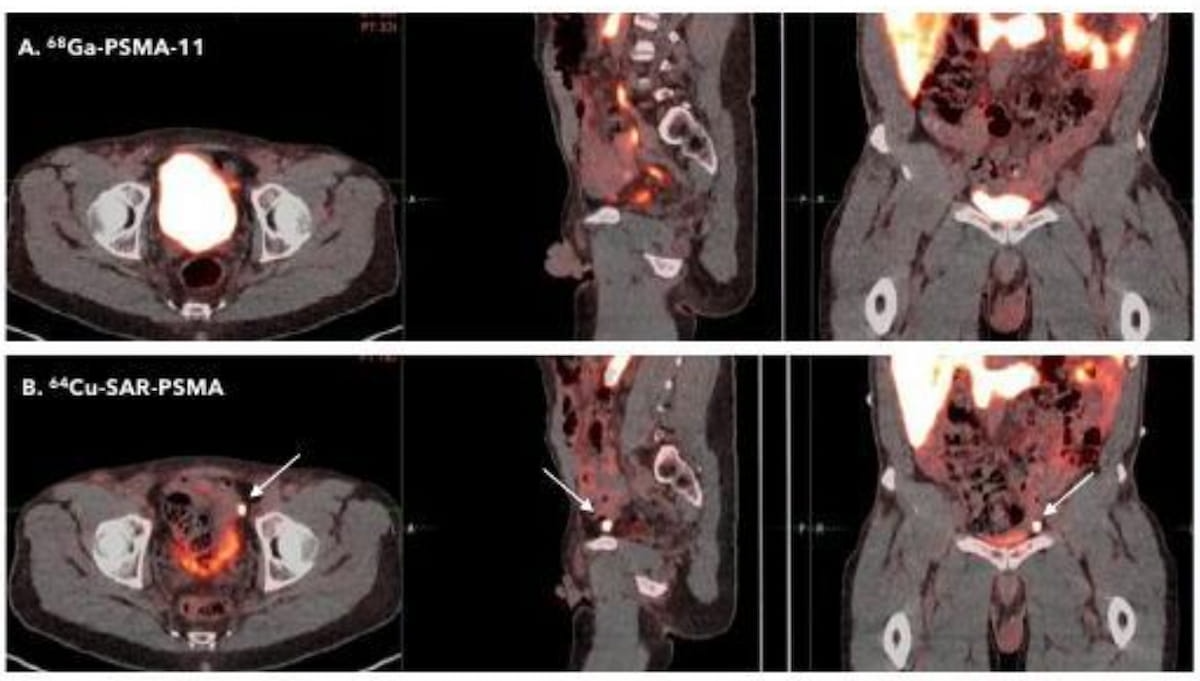Could there be a new standard of care for prostate-specific membrane antigen (PSMA) positron emission tomography (PET) detection of prostate cancer?
In a study that was presented at the recent Society of Nuclear Medicine and Molecular Imaging (SNMMI) conference, researchers compared initial PSMA PET imaging with 68Ga PSMA-11 PET/CT to different dosing regimens of the PSMA PET agent 64Cu SAR-bisPSMA in 30 men with intermediate to high-risk prostate cancer. The study authors noted the dosing cohorts for 64Cu SAR-bisPSMA were 100 MBq, 150 MBq and 200 MBq. All PSMA PET scans were assessed by two blinded readers, according to the study.
The first reader diagnosed 63 prostate cancer lesions with 64Cu SAR-bisPSMA versus 51 lesions with 68Ga PSMA-11 PET/CT across all cohorts, and the second reader detected 34 lesions with 64Cu SAR-bisPSMA in comparison to 25 lesions with 68Ga PSMA-11 PET/CT, according to the phase 1, prospective, multisite study.
The researchers found that use of 64Cu SAR-bisPSMA resulted in a higher median SUVmax for the readers (30.3 and 41.7) in contrast to 68Ga PSMA-11 PET/CT (13.5 and 14.9). The study authors also noted that 64Cu SAR-bisPSMA had a significantly higher SUVmean (21.2 vs. 9.1 for the first reader and 28.4 vs. 9.94 for the second reader) and higher median tumor-to-background (TBR) ratios (53.6 vs. 24.3 for the first reader and 78.4 vs. 24.7 for the second reader) in comparison to 68Ga PSMA-11 PET/CT.
 Noting that 64Cu SAR-bisPSMA may offer “improved tumor uptake and retention compared to PSMA monomers,” researchers found that the PSMA PET agent had significantly higher SUVmax and SUVmean in comparison to 68Ga PSMA-11 in a recent study. (Images courtesy of the Society for Nuclear Medicine and Molecular Imaging.)
Noting that 64Cu SAR-bisPSMA may offer “improved tumor uptake and retention compared to PSMA monomers,” researchers found that the PSMA PET agent had significantly higher SUVmax and SUVmean in comparison to 68Ga PSMA-11 in a recent study. (Images courtesy of the Society for Nuclear Medicine and Molecular Imaging.)
“More lesions were detected, and lesions exhibited higher SUVmax, SUVmean and TBR by 64Cu SAR-bisPSMA compared to 68Ga PSMA-11 in men being staged with intermediate- and high-risk (prostate cancer),” wrote study co-author Louise Emmett, M.D., the director of the Department of Theranostics and Nuclear Medicine at St. Vincent’s Hospital in Sydney, Australia, and colleagues.
(Editor’s note: For related content, see “Is Pre-Imaging Biopsy Necessary for Prostate Cancer Staging in Elderly Patients?,” “Utilizing AI for Quantitative Assessment of Prostate Cancer Recurrence” and “Emerging PET Radiotracer May Offer Multiple Advantages in Detecting Prostate Cancer.”)
In contrast to other PSMA agents that have a single targeting functional group, the study authors said a key advantage of 64Cu SAR-bisPSMA is two PSMA-targeting functional groups.
“This can lead to improved tumor uptake and retention compared to PSMA monomers, which may be highly relevant in patients with suspected disease or suspected recurrence where the detection of lesions may lead to a change in management,” noted Emmett and colleagues.
(Editor’s note: For additional content and video interviews from the SNMMI 2023 conference, visit https://www.diagnosticimaging.com/conferences/snmmi .)
Clarity Pharmaceuticals, the developer of 64Cu SAR-bisPSMA, is reportedly planning to initiate a prospective phase 3 study of the agent later in 2023.
Reference
1. Lengyelova E, Wong V, Lenzo N, Parker M, Emmett L. Comparison of PET/CT in subjects with confirmed prostate cancer using 64Cu SAR-bisPSMA and 68Ga PSMA-11. Poster presented at the Society of Nuclear Medicine and Molecular Imaging (SNMMI) 2023 Annual Meeting, June 24-27, 2023, Chicago. https://am.snmmi.org/iMIS/SNMMI-AM?utm_source=dropdown&utm_medium=website&utm_id=AM2022&navItemNumber=581